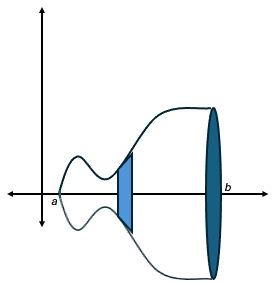Suppose that you are a bowl manufacturer and that you need to… Eh, forget it. I won’t pretend with this one. This is a math post.
How do you find the volume of a bowl? If you already have the bowl, you could simply fill it with water, and then transfer the water to a measuring cup. (This is the investment banking interview / Die Hard with a Vengeance approach.) Here’s a way you can do it even if you only have the blueprints for the bowl.
Volumes of solids of revolution
In most cases, a bowl (or vase) will have rotational symmetry. This means that you can trace it out by drawing a two-dimensional curve, and then rotating that curve around a fixed axis. Here’s an example:
The volume of such a shape can be approximated by adding up the areas of a bunch of thin cylindrical disks, whose radii are given by the distance from the axis to the curve at a given point.

The volume of any one of these cylinders is given by the formula
where x* is a representative point inside the cylinder. (Think base times height, where “base” is the area of a circle.) To approximate the volume of the bowl, simply add up the area of all the disks:
The number of rectangles i gets larger as the width Δx decreases. Your estimate of the volume also improves as the disks get smaller (and more plentiful). The exact volume is found by sending the width Δx to 0, which yields an integral.
Let’s look at an example. A paraboloid (such as a satellite dish) can be obtained by rotating a parabola y = x^2 around the y-axis. Since we’re more accustomed to viewing y as a function of x, let’s instead rotate the curve x = y^2 around the x-axis. The volume is equivalent: we’re just putting the dish on its side. To do this, you have to write y as a function of x, meaning that you take the square root of both sides. Picking bounds of, say, x = 0 to 1, this gives a volume of

Surface area of surfaces of revolution
In the preceding section, I computed volumes of revolution by approximating shapes with cylindrical disks. You can use a similar strategy to compute the surface area of surfaces of revolution. This time, instead of using disks to approximate the volume, I’m going to use the area of thin bands stretched around the outside of the surface.
It turns out that there’s a slight wrinkle with surface area. You might expect that a small enough band will look like a cylinder, whose surface area (without the caps) is 2*pi*r*h, where r is the radius, and h the height (cf., picture below).
This is almost true, except that the bands are going to have a larger area where the curve is steeper. Think about what it would look like if you took the trapezoidal band above and revolved it around the x-axis. You end up with a cone (e.g., paper water cup) with the tip chopped off. (The technical term is the frustum of a cone.). If you unravel that, you’ll end up with a curved trapezoid instead of a rectangle, which is what you get when you unravel a cylinder. It would look something like this.

For a fixed inner radius r, the surface area of the frustum increases as the steepness of the cone increases. (This corresponds to the side labeled H getting longer.) This means that even as our bands get “infinitely thin,” we still have to account for the steepness of the curve at each point. The steepness of the curve is captured by the derivative. I’ll spare you the full derivation and just show the formula.
If you ignore the square root term, you get the integral of 2π*f(x), which resembles the area of a cylinder. Since the term under the square root is always bigger than 1, this says (roughly) that the surface area will be bigger than the cylinder if the curve has any slope to it at all. This formalizes what we saw in the picture.
The Horn of Gabriel
Now that we have formulae for the surface area and volume of shapes of revolution, I can explain the “painter’s paradox”. It has to do with painting a surface of revolution called the Horn of Gabriel. The Horn of Gabriel is the shape obtained by revolving the curve y = 1/x around the x-axis from x = 1 to ∞.

As x approaches ∞, 1/x approaches 0. It’s therefore possible—but not guaranteed—that this shape will have finite volume and surface area. Let’s start with computing the volume. Per the formula from the first section:
(This is called an improper integral, since one of the bounds is ∞. To compute this rigorously, replace ∞ with b and compute the limit of the integral as b goes to ∞.) As we see, the volume of Gabriel’s Horn is finite, meaning that you could fill it with a finite volume of liquid.
What about the surface area? Applying that formula yields
To the best of my (admittedly rusty) knowledge, there is no antiderivative for that integral. However, since the square root term is bigger than 1, the integrand is always going to be bigger than 1/x. We can therefore say that
This shows that the Horn of Gabriel has finite volume, but infinite surface area. So you can fill it up with a finite amount of paint, but you can’t coat the surface of the horn with a finite amount of paint. But do you not coat the inside of the horn when you fill it up with paint? I think we just found a glitch in the matrix.






